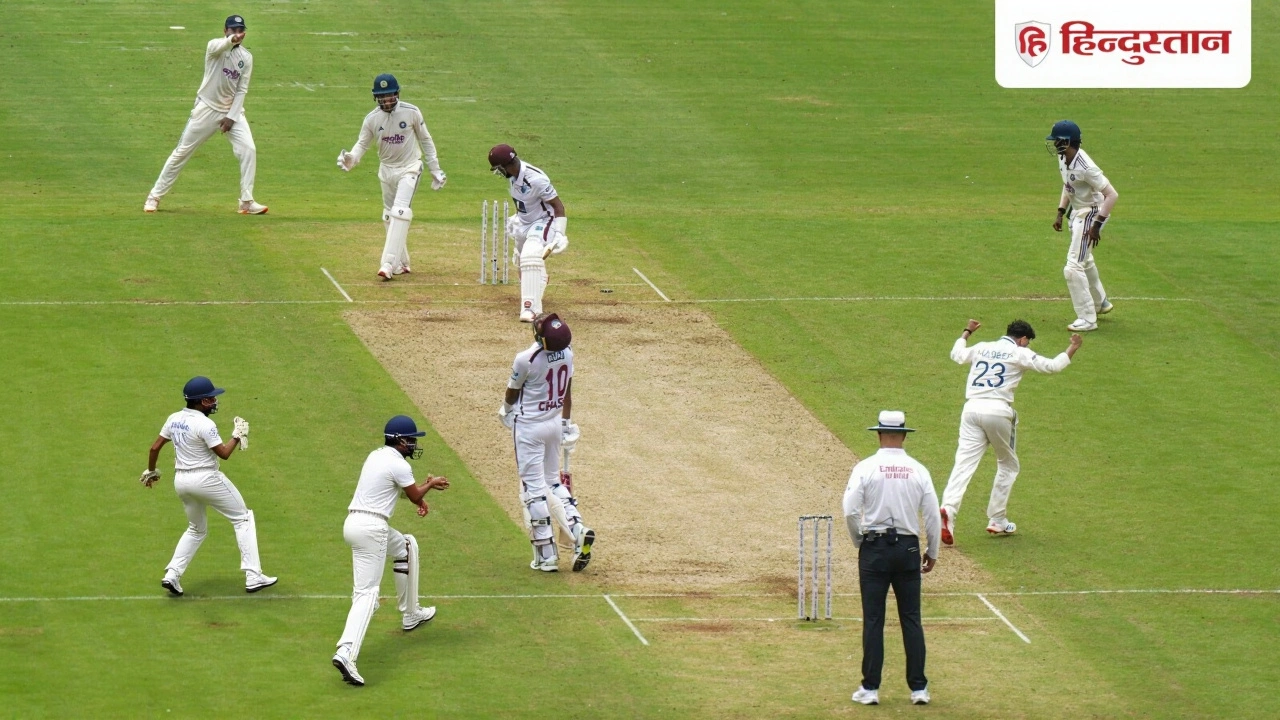When Kuldeep Yadav delivered a spinning masterpiece on Thursday, the cricket world held its breath — and so did Shai Hope. The Kuldeep Yadav, India’s master of the chinaman, bowled a delivery so deceptive that Hope, one of the Caribbean’s most composed batters, stood frozen at the crease, staring at his stumps — still in place — as if waiting for an explanation that never came. The ball, launched from outside off-stump with deceptive flight, dipped sharply after pitching, whipped back through the air, and cleanly removed the off-stump. Hope didn’t move. He didn’t walk. He just... stood there. For nearly five seconds. The silence in the Bridgetown crowd was louder than any cheer.
A Comeback That Shook the Pitch
Kuldeep Yadav hadn’t played a Test for India since the England series last year. Brought back into the playing XI by captain Shubhman Gill for the two-match series against the West Indies, his selection was seen as a gamble. India’s pitch in Bridgetown, traditionally slow and low, favored spin — but few expected Kuldeep to dominate so emphatically. He didn’t just bowl well. He bowled like a man who’d spent months in the shadows, sharpening his craft in silence. In 6.1 overs, he conceded just 25 runs and claimed two wickets — the first of them a moment of pure genius.
The Ball That Broke Hope’s Belief
It was the second ball of the 24th over. Hope, who had batted through the morning session with calm authority, stepped forward, expecting drift and turn. What he got was a trap. Kuldeep’s chinaman spun not just off the pitch, but off expectation. The ball floated lazily, almost invitingly, before dropping like a stone. It kissed the surface, then snapped back with a vicious, almost unnatural angle. The off-stump cracked clean. Hope’s bat never moved. His eyes widened. He looked down at his stumps, then at the umpire, then back at his stumps — as if the laws of physics had betrayed him. He remained rooted to the crease, arms slightly raised, disbelief etched across his face. It took the third umpire’s confirmation and a gentle nudge from his teammate to finally send him walking.
Why This Wicket Mattered More Than the Runs
Shai Hope isn’t just any batter. He’s the backbone of the West Indies’ middle order — a man who’s batted over 500 minutes in a single Test innings. Getting him out cheaply, especially with a delivery that looked like a mistake, sent shockwaves through the visitors’ camp. India, having bundled out the West Indies for just 162 in 44.1 overs, now held the complete upper hand. And it wasn’t just Kuldeep. Alongside Ravindra Jadeja and Ravichandran Ashwin, India’s three-spin attack turned Bridgetown into a spinning labyrinth. The West Indies batters, used to pace and bounce, looked lost. Three spinners in the XI? It was bold. It was risky. And it worked perfectly.

From Bench to Brilliance
Kuldeep’s journey back to the Test team was anything but smooth. After being dropped during the England tour, he spent months working on his consistency and control. He didn’t play domestic cricket for months. He trained alone. He studied footage of his own deliveries, frame by frame. He didn’t just want to return — he wanted to remind everyone why he was ever picked in the first place. And on that Thursday in Bridgetown, he did more than remind. He announced himself. His two wickets weren’t just numbers — they were statements. The first, to Hope, was art. The second, to Alzarri Joseph, was execution. He finished with figures of 2 for 25 — the most economical spell of the innings.
What This Means for India’s Spin Strategy
India’s decision to field three spinners on a Caribbean pitch isn’t just tactical — it’s psychological. It signals confidence. It says: ‘We don’t need pace here. We can out-think you.’ And with Kuldeep back in form, India now has a lethal weapon in conditions where spinners traditionally struggle. The West Indies, who’ve lost three of their last four Tests, now face an uphill battle. And with the second Test looming in St. Lucia, India’s spin trio could be the difference-maker.

Behind the Scenes: The Science of the Chinaman
What made Kuldeep’s delivery so devastating wasn’t just the turn — it was the deception. The chinaman, a left-arm wrist spin delivery, behaves like a leg-spinner’s googly. But when bowled with flight and variation in pace — as Kuldeep did — it becomes nearly impossible to read. The ball appears to be heading wide, then snaps back sharply. Batters often commit early, expecting drift. Kuldeep didn’t just bowl a good ball. He bowled a ball that exploited decades of battering habits. Cricket analysts say this is the kind of delivery that redefines careers. For Hope, it was a humbling moment. For Kuldeep, it was redemption.
Frequently Asked Questions
How did Kuldeep Yadav earn his place back in the Indian Test team after being dropped?
After being left out of the England Test series, Kuldeep Yadav focused on refining his control and consistency in private training sessions. He didn’t play domestic cricket for months, instead studying match footage and working with spin coaches to perfect his chinaman’s flight and grip. His return was a calculated move by captain Shubhman Gill, who believed the slow Bridgetown pitch would suit India’s spin-heavy attack — a gamble that paid off with immediate impact.
Why was Shai Hope so stunned by the delivery?
Hope, known for his calm technique against spin, expected the ball to drift away. Instead, Kuldeep’s chinaman floated wide, then snapped back sharply after pitching — a movement so unexpected that Hope didn’t react in time. The ball didn’t just turn; it deviated in the air, making it nearly impossible to read. Even replays showed Hope’s bat frozen mid-air — he simply didn’t believe the ball could turn that much, or that fast.
Is this the first time a chinaman has dismissed a top-order batter in such a dramatic fashion?
No — but it’s rare. In Test cricket, only a handful of dismissals by chinaman bowlers have left batters visibly stunned at the crease. The most famous was Anil Kumble’s dismissal of Michael Vaughan in 2002, but Kuldeep’s delivery to Hope stands out for its flight, deception, and the batter’s physical reaction. It’s the kind of moment that gets replayed for years — not just for the skill, but for the human disbelief it captured.
What impact could this have on India’s upcoming Test matches?
With Kuldeep back in form and India’s three-spin attack proving effective even outside Asia, the team now has a new strategic edge. The second Test in St. Lucia, with its similar slow pitch, could see even more spin-heavy selections. If Kuldeep maintains this form, he could become India’s first-choice wrist spinner in overseas conditions — a role once held by Anil Kumble and later by Ravichandran Ashwin.
How does Kuldeep Yadav’s performance compare to other Indian spinners in the Caribbean?
Historically, Indian spinners have struggled in the West Indies due to pace-friendly pitches. Kuldeep’s 2 for 25 in 6.1 overs is the most economical spell by an Indian spinner in the Caribbean since Harbhajan Singh’s 3 for 32 in 2006. More impressively, he did it without the benefit of a spinning pitch — relying purely on variation and flight. His performance is being compared to Ravi Ashwin’s 2018 series in South Africa — another instance where spin triumphed against the odds.
What’s next for Shai Hope after this dismissal?
Hope has publicly acknowledged the quality of the delivery, calling it ‘one of the best balls I’ve ever faced.’ He’s not blaming the pitch or the umpire — he’s analyzing his footwork. He’ll likely adjust his stance and foot movement in the second Test, but the psychological blow remains. For a batter of his caliber, being frozen by a single ball can linger — especially when it’s broadcast worldwide. His next innings will be closely watched.

